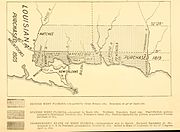
A 1903 map showing the territorial changes of "West Florida"
The West Florida Controversy refers to two border disputes that involved Spain and the United States in relation to the region known as West Florida. The first dispute commenced immediately after Spain received the colonies of West and East Florida from the Kingdom of Great Britain following the American Revolutionary War, and continued for nearly four decades. Initial disagreements were settled with Pinckney's Treaty of 1795.
The second dispute arose following the Louisiana Purchase in 1803. The controversy led to the secession of the bulk of West Florida, known as the "Republic of West Florida," from Spanish control in 1810, and its subsequent annexation by the United States. In 1819 the United States and Spain negotiated the Adams–Onís Treaty, in which the United States purchased the remainder of Florida from Spain.
First border dispute[]
Britain formed the territory of West Florida out of territory it received from Spain and France in the 1763 Treaty of Paris, which ended the French and Indian War (the Seven Years' War). In this treaty it received all of Spanish Florida from Spain, and nearly all of French Louisiana east of the Mississippi River from France. Finding the new territory too big to govern from one capital, the British divided it into two new colonies: West Florida, with its capital at Pensacola, and East Florida, with its capital at St. Augustine.
Twenty years later, Britain ceded both Floridas to Spain following the American Revolutionary War. They did not, however, specify the boundaries of West Florida, which had changed over the course of British stewardship. In the British period West Florida's northern border was initially set at the 31st parallel north, but was moved to 32° 22′ in 1764 in order to give the West Floridians more territory, including the Natchez District and the Tombigbee District. Spain insisted that its West Florida claim extended fully to 32° 22′, but the United States asserted that the land between 31° and 32° 22′ had always been British territory, and therefore rightfully belonged to the United States. After years of disagreement, the dispute was finally resolved with Pinckney's Treaty in 1795, in which both parties agreed on the 31st parallel as the boundary between the United States and West Florida.
Second border dispute[]
Before 1762 France had owned and administered the land west of the Perdido River as part of La Louisiane. In 1762 France secretly ceded its lands west of the Mississippi River plus the land west of the Perdido River to Spain. Excluding the island of New Orleans, the area between the Mississippi and Perdido Rivers became part of Spanish Florida.
At the end of the Seven Years' War in 1763, France ceded its remaining lands east of the Mississippi River to Great Britain, while Spain ceded its entire Florida colony to Great Britain. The British created the colony of West Florida out of the French and Spanish cessions. In 1783, Great Britain transferred both East and West Florida back to Spain, who ruled both provinces as separate and apart from Louisiana. In 1800, under duress from Napoleon of France, Spain ceded Louisiana and the island of New Orleans to France, who promised to return them to Spain should France ever relinquish them. When France then sold the Louisiana Territory to the United States in 1803, a dispute arose between Spain and the United States regarding whether West Florida was part of the Louisiana Purchase. The United States laid claim to the region of West Florida between the Mississippi and Perdido Rivers, asserting it had initially been part of French Louisiana. Spain held that such a claim was baseless.
In 1810, a group of discontented American and British settlers in the area of Baton Rouge learned that the Spanish colonial governor, who had feigned sympathy, was in fact mounting a force against them.[1] They revolted by overrunning a Spanish garrison at Fort San Carlos in Baton Rouge on September 23, 1810,[2] and declared the independence of the Republic of West Florida on September 26.[1] On October 27, the United States president proclaimed the annexation of the territory, and Spain, then embroiled in the Peninsular War with France, could do little to resist. On December 10, the United States military completed the forcible occupation and acquiescence of the Republic of West Florida.
In 1819 the United States and Spain negotiated the Adams–Onís Treaty, in which Spain sold the remainder of West Florida and all of East Florida to the United States.
References[]
- ↑ 1.0 1.1 Chambers, Henry E., ed (May 1898). "West Florida and its Relation to the Historical Cartography of the United States". Baltimore, Md.: The Johns Hopkins Press. https://ia801407.us.archive.org/12/items/westfloridaitsre00cham/westfloridaitsre00cham.pdf. Retrieved 2015-06-28.
- ↑ Davis, William C. (May 2013). "The History of the Short-Lived Independent Republic of Florida". Smithsonian Magazine. http://www.smithsonianmag.com/history/the-history-of-the-short-lived-independent-republic-of-florida-28056078/?utm_campaign=Feed%3A+smithsonianmag%2Fhistory-archaeology+%28History+%26+Archaeology+%7C+Smithsonian.com%29%7CThe&utm_medium=feed&utm_source=feedly. Retrieved 2015-06-28.
External links[]
- “Not Merely Perfidious but Ungrateful”: The U.S. Takeover of West Florida by Robert Higgs (2005)
- Arthur, Stanley Clisby, The Story of the West Florida Rebellion. St. Francisville, La.: St. Francisville Democrat.
- Cox, Isaac Joslin (1918). West Florida Controversy, 1798–1813; A Study In American Diplomacy, ISBN 0-7812-6301-8
- McMichael, Andrew (2008). Atlantic Loyalties: Americans in Spanish West Florida, 1785–1810. University of Georgia Press. ISBN 978-0-8203-3004-4.
The original article can be found at West Florida Controversy and the edit history here.